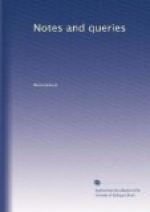Permit me to avail myself of the “good the bounteous gods have sent me,” and make one or two inquiries through the medium of your columns. {184} In the first place, can any of your readers inform me by whom a pamphlet, of the Elizabethan period, noticed in the Censura Literaria, and entitled The Fraternitye of Vagabondes, was reprinted, some years since?—Was it by Machelle Stace, of Scotland Yard, who died a brother of the Charter-House?
In the second place, can any of your clerical readers tell me where I can find any account of the late Rev. Mr. Genesse, of Bath, author of a History of the Stage, in ten volumes, one of the most elaborate and entertaining works ever published, which must have been a labour of love, and the labour of a life?
And, in the third and last place, I find, in the Bristol Gazette of the early part of last month, the following paragraph:—“THE RED MAIDS, 120 in number, enjoyed their annual dinner in honour of the birthday of their great benefactor, Alderman Whitson. The dinner consisted of joints of veal (which they only have on this occasion), and some dozens of plum puddings. The mayor and Mayoress attended, and were much pleased to witness the happy faces of the girls, to whom the Mayoress distributed one shilling each.”
Can any of your curious contributors give me any account of these Red Maids?—why they are so called, &c., &c.?—and, in fact, of the charity in general?
It will not be one of the least of many benefits of your publication, that, in noticing from time to time the real intention of many ancient charitable bequests, the purposes of the original benevolent founder may be restored to their integrity, and the charity devoted to the use of those for whom it was intended, and who will receive it as a charity, and not, as is too often the case, be swallowed up as a mere place,—or worse, a sinecure.
ARTHUR GRIFFINHOOF, JUN.
* * * * *
THE NAME OF SHYLOCK.
Dr. Farmer has stated that Shakspere took the name which he has given to one of the leading characters in the Merchant of Venice from a pamphlet entitled Caleb Shilloche, or the Jew’s Prediction. The date of the pamphlet, however, being some years posterior to that of the play, renders this origin impossible. Mr. C. Knight, who points out this error, adds—“Scialac was the name of a Marionite of Mount Libanus.”
But “query,” Was not Shylock a proper name among the Jews, derived from the designation employed by the patriarch Jacob in predicting the advent of the Messiah—“until Shiloh come”? (Gen. xlix. 10.) The objection, which might be urged, that so sacred a name would not have been applied by an ancient Jew to his child, has not much weight, when we recollect that some Christians have not shrunk from the blasphemous imposition of the name Emanuel ("God with us”) upon their offspring. St. Jerome manifestly reads SHILOACH, for he translates it by Qui mittendus est. (Lond. Encyc. in voc. “Shiloh.”) Now the difference between Shiloach and Shylock is very trivial indeed. I shall be very glad to have the opinion of some of your numerous and able contributors on this point.




